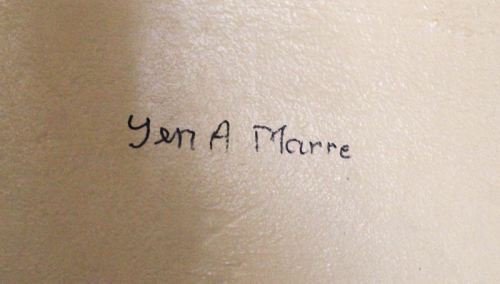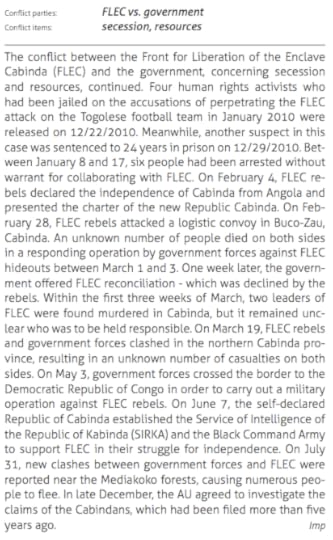Sean Jacobs's Blog, page 545
April 1, 2012
The new type of Senegalese
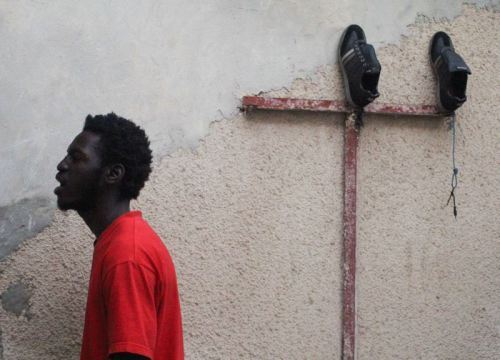
Just in case you were busy being distracted by Kony2012 or the rising sales of Hoodies, I am pleased to inform you that after their 25 March 2012 election, the people of Senegal voted for the removal of Abdoulaye Wade, and his son Karim Wade (better known as Wade & Wade). In a twist of fates, a former protégée of Mr. Wade, Macky Sall, who had a falling out with Mr. Wade for wanting accountability from Karim over corrupt governmental expenditures has been elected President. Some foreign correspondents (on Twitter) have suggested that Mr. Wade be awarded the Mo Ibrahim Prize (given to former African presidents) for accepting defeat gracefully and peacefully. One might be prone to join the bandwagon if one thought that six people being killed, multiple people being injured and arrested, the Constitution and Constitutional Court being manipulated, and supporters of opposition being intimidated can be counted as "peaceful and graceful". That said, this is really about one of the major stakeholders that contributed to the ousting of Wade&Wade — Y'en A Marre.
Y'en A Marre (Enough is Enough) is a youthful grassroots social movement group founded by a small group of rappers including Thiat (Cheikh Oumar Cyrille Touré) and Kilifeu (both of the famed hip-hop band "Keur Gui of Kaolack", Fou Malade (Malal Talla) and two journalists: Fadel Barro, Aliou Sane and Denise Sow. Its membership has soared in the couple of years since it was formed, with multitudes of unemployed youths and artists in the country identifying it as their mouthpiece and joining the group in its rallies leading to the first round of elections in the country in February. Several members of the founding core tram and their followers were arrested, beaten and intimated by the state's apparatus. However, this failed to silence the group which claims it was and still is voicing the frustrations of the people including seeking fair elections which they hoped would lead to Wade's departure, and arousing the aspirations of the people for a new way of thinking and living which they call the New Type of Senegalese (NTS). Apart from the protests and rallies, the group also utilized revolutionary laced lyrical rap and hip hop as means of spreading its message, capitalizing on its founders' 'street cred'. At the end of last year, the group released a compilation, self-titled "Y'en A Marre".
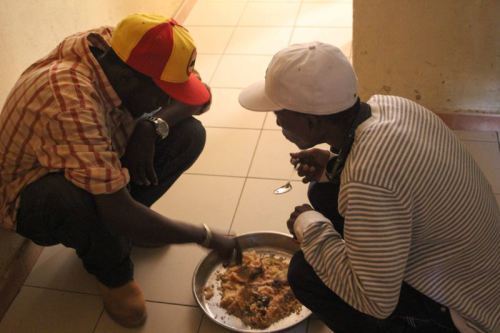
The single "Faux! Pas Forcé" from the compilation was the group's anthem in its protests and one of the more popular anthems for the ouster of Wade & Wade. Despite the groups' claim at neutrality, indicated by the support for various candidates by its members during the first round of elections, one unifying factor for it was the ouster of Wade & Wade. Nothing inspires better warfare than a common single enemy. After the first round of elections, the group in an unlikely move actually came out and threw its weight behind Macky Sall while still calling for NTS. This was followed up with release of a new Rap Single titled "Doggali" (let's finish it) to emphasize finishing the job of cleansing the country of Wade & Wade. It would be an interesting exercise to attempt quantifying Y'en A Marre's impact at Wade being defeated at the polls (any PhD students reading this?), but an impact they did make.
Now that Wade & Wade have been booted out, one cannot but be tempted to ask "what next" for Y'en A Marre?

Well, that depends on who you ask. Some members of the press have begun to erase the role of this group to the point of diminishing "Y'en A Marre" to just a rally cry by the opposition. Members and supporters of the group, including Keyti (a veteran rapper), believe the group will not disintegrate as it stood for more than just ousting Wade and can be a platform for actual social changes in Senegal. Other more established academics and political veterans, off the record, believe Y'en A Marre is as good as dead in the new political make up of the country unless it reforms itself and joins or support more traditional political institutions in the country.
So which point of view might be 'more' correct?
History and precedence might be of help here. As most followers of all things Senegal know already, the country has a history of youth, both educated and uneducated, leading revolts and social movements. In the 1990s, there was the Set/SetaZ movement for the purpose of cleansing in the sense of sanitation & hygiene and the moral sense, including the fight against corruption, prostitution, and delinquency. That movement's primary concern was to rehabilitate their local surroundings and remove garbage and filth. Then in 2000, a brilliant politician, as part of his Sopi (Change) campaign, strategically deployed rap music artists, who were generally looked down upon by previous governments and society at large, to spread his message. That politician understood very well that Rap music had grown out of youth discontent with the way society had been progressing and utilized their talent and time, which the rappers had much of, to bolster his Sopi campaign. Rappers like DJ Awadi of Positive Black Soul helped to galvanize a youthful constituency to help elect the politician as the new president. That politician was none other than Abdoulaye Wade. Of course, after he got the presidency, he disregarded the scores of youths and rap artists that supported him and pandered instead to wealthy and influential members of the business community, which included prominent Mourid (religious brotherhood) leaders.
Once bitten, by the 2007 election, and critical of Wade's tendency to overlook them the youths hoped Senegal's subsequent election might offer an opportunity to find an even more devoted leader. Awadi, whose fame had risen even more by then, attempted to galvanize the youths with rap music once again and produced an internet sensational single entitled "Sunugaal" (canoe). The music was a pointed critique of the Wade government that he believed had betrayed and then encouraged Senegalese youth to "risk their lives to seek fortunes abroad." The lyrics included the following lines:
You promised me we would have jobs,
You promised me we would have food,
You promised me we would have real work and hope, But so far—nothing.
Fast forward to where we find ourselves now. The naysayers point to this history of haphazard youth involvement in the governance of the country to validate their gloomy outlook of Y'en A Marre. To buttress their claims, it is no secret that the newly elected president has yet to really make nice with the youth or rap community of Senegal, nor has he fully acknowledged the impact they had in getting rid of Wade&Wade. In addition, it is much easier to lead a group when fighting a common enemy embodied by one, or two, corrupt body that all ires can be directed at with full strength. Attempting to sustain a movement like Y'en A Marre based on a program like NTS might be a tougher sell.
However, the naysayers might also be underestimating this movement. For one, Y'en A Marre was supposedly not created nor manipulated by any political operator(s). Or was it? It would be interesting to see where the core members of the group end up in the new political landscape for this answer. Either way, with the strategic and adept showcase of the utilization of technology, networking, media manipulation and street power that the rappers have learned and shown in this elections, it would be a mistake for any of the old guards of politics to underestimate them at this stage. An attempt at pulling a Wade after this elections might not meet the same deference expected of the rappers and youths in the past. My gut feeling is that Y'en A Marre is not out of breath yet and might still have one or 2 tricks up their sleeve.
* All photos by 'kola.








Yes, Sudan made movies
After a week of being bombarded with all sorts of "good news" from the horn of Africa regarding oil and bombings, I decided to use the weekend to search for days of normalcy in Sudan. No, I did not fly to Khartoum but I got a quick memory lane trip via Cinema in Sudan: conversations with Gadalla Gubara (2007), a documentary by Frederique Cifuentes Morgan, who can be described as having a healthy obsession with Sudan evidenced by her three feature length documentary films about the country. This documentary follows the great Sudanese filmmaker, Gadalla Gubara (1920-2008), one of the pioneers of cinema in Africa and especially cinema in Sudan. Screened at Columbia University, the documentary provides a space and voice for an old man to tell his story to a country that is distracted. A titbit about Gadalla. In 1969, it was Gadalla and his pals, Ousmane Sembene, Timité Bassori, Mustapha Alassane that came up with a revolutionary idea: the Panafrican Festival of Cinema and Television of Ouagadougou (FESPACO). It is indeed ironic and saddening that he died the year after the documentary came out. Apart from the quick wit and humor of Gadalla Gubara and the beautiful reels of old Sudanese movies, one cannot help but be captivated by the music accompanying the documentary. My Sudanese movie-watching companion could not stop singing along throughout the documentary. Music by Waleed Waselny Norak and Sherhabeel Ahmed felt magical (not exaggerating here). I left feeling like I hardly know Sudan. Perhaps Gadalla is right and Sudan is indeed misunderstood? His Sudan anyways, or perhaps my Africa. Now, who has a copy of Tagoog for a movie night?
Here's a taste of Sharhabeel Ahmed's music:
* This post marks the debut post of 'kola (Bukola Jejeloye) for AIAC.

Brand Kuduro
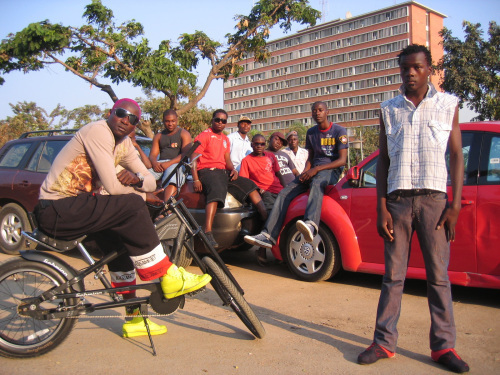
Photo: Jorge Antonio, director of "Kuduro: Fogo no Museke"
Kuduro has already received some attention on AIAC (btw, is this Cabo Snoop clip intra-continental cultural colonialism?). Kuduro means 'hardass' or 'in a hard place' in Angolan Portuguese or a mix of Portuguese and Kimbundu, depending on how you parse it. And unlike most kinds of Angolan music it has garnered something of an international audience over the years, quite independent of the formal commercial channels of music promotion, be they national or international.* This new video by MC Sacerdote and Dama Linda "Xé! O que falaste!" (Hey! What did you say?) is a good example.
Produced by the Swedish production outfit, Stockton, the production quality is high and emphasizes the hopeful, horizontal ethics of new technologies. Co-produced with the Angola company Geração 80, the video films Sacerdote and his crew in the musseque Sambizanga, famous for its musicians and kuduristas, as they stop now legendary Luanda traffic and dance on trucks and candongueiros (local blue and white collective taxis and some of the main vectors for spread of new music). I'm struck by the bright green water tank and the Angolan flag, both ubiquitous in Luanda's visual landscape, the former a sign of the failure of urban infrastructure and the latter a sign of state structure.
Kuduro has been around since the mid-1990s and kuduristas speak of at least three generations of artists. MC Sacerdote and Cabo Snoop are of the youngest generation. The second generation included artists like DJ Kilamu, feisty female artists like Fofandó, and os Lamba, the most notorious Sambizanga based kuduristas. Check out this clip of theirs and the amazing dancing in the tight musseque corners where one of their band members was murdered
The earliest kuduro artists and animators like Tony Amado and Sebem produced a new form of music and dance drawing from local and foreign sources in midst of the long years of Angola's civil war. Amado claims inspiration for the dance from Van Damme in the film "Kickboxer," though kuduro dance moves certainly have much that is Angolan about them, and claims foundational status for himself.
After Cold War support dried up for Angola's civil war and popular enthusiasm turned to cynicism, the state and rebel leaders used national resources like oil, diamonds and young people to continue the war. Young men were recruited by both sides to do the fighting. Kuduro dance and music reclaim those bodies for pleasure and a different sort of heroics (for more on this see the piece by German academics Stefanie Alisch and Nadine Siegert). Since the war ended kuduro music and dance have become more commercially driven, more colorful, more lyrically complex and more fashion-centered (though for Sebem swag has always been front and center, even his cars often integrate into the day's outfit). In fact, one US marketing firm called it a 'lifestyle,' in that vertically optimistically and interested sort of way.
* Sadly, the popularity of kuduro in clubs (even without those on the dance floor knowing the origins of the sounds that move them) has had little affect on ignorance about Angola.

March 31, 2012
'The Love Mantra'
New video for single from Brooklyn-based Rwandan singer Iyadede's new album, "The Demo." (Remember her recent cover of Theophilus London's "Flying Overseas"? The video is directed by Sam Kessie.

March 30, 2012
Friday Bonus Music Break
One of my favorite MCs / hip hop producers, Damu the Fudgemunk. I always check for his new work. (Reminds of the same sensibility of Madlib.) The video, below, is from 2009′s Madvillian. And this link is to his latest work.
So the main rapper on this Tanzanian track is a teacher and the featured artist is his student. The kid, Dogo Janja, is considered a star for the future. The song talks about the lack of pay and respect for teachers–no prizes for guessing the name of the great teacher whose pic flashes at the conclusion of the video.
Nigerian wedding music from Nigerian-American Eldee: Golden Arrow buses, Table Mountain, colonial statues in the company gardens. Is Cape Town the honeymoon spot for cool newlyweds or for shooting music videos on budget? Hey Europeans and Americans do it already.
A video preview of Chief Boima collaborator DJ Lamin Fofana's latest:
Finally, some Yoruba soft jazz by Dipo (no not Diplo obviously) with "Be Your Man." There's also the freestyle version with Ghanaian vocalist Enya.








French Tropicalism
At the occasion of the recent publication of Senegalese philosopher Souleymane Bachir Diagne's book 'African Art as Philosophy: Senghor, Bergson and the Idea of Negritude' (originally published in French in 2007) and listening to this interview where he speaks about his new book, 'Bergson Postcolonial', I intended to write a short post wondering why it often takes years before important work by African authors (both fiction and non-fiction) that is originally published in French becomes available in English — if at all. Browsing through English news and culture blogs focussing on 'all things African', one does find a lot of visual work (by francophone artists, fashionistas or musicians) because that work is easy to blog and reblog (Tumblr & co), but when it comes to engaging with French opinions and writings… it's a desert out there.
It's hard to shake off the feeling the result is a virtual and cultural space consisting of two separate worlds missing out on each other's written work. Short, a post on why French African authors matter and why they are often absent on English platforms. Until I came across the argument above, by Souleymane Bachir Diagne himself, who expresses their importance far more eloquently than I could have. (As a scholar of Léopold Senghor's work and as a friend of Ngũgĩ wa Thiong'o, Diagne couldn't leave them out of the argument.) In English.
I'll still make that list of French works which I believe need to be translated and read — another day.








March 29, 2012
Music Break. Rabbit
Kenyan artist Rabbit is working hard to get the word out about his new album Orutu Ya Masudi. The music video for 'Yesterdays' (and The Main Ingredient's inspiration) will help.








Mali's Democracy–Down but not out

It's windy in Bamako, says Martin Vogl, a journalist who's been there for about three years now. Vogl and some of his peers are doing a great job in reporting what's going on. But with all that wind blowing, and with things happening so fast, it's helpful too to have shelter from the storm. A little analysis from one step's remove might be useful. Here's another attempt to offer that, to try to think clearly and speak plainly, even if everything is provisional. Post-mortems on Mali's democracy are premature. Why do I think that's so?
First, because the junta seems to be spinning without a rudder. Confronted with demands from Mali's political leaders, from regional and international bodies like the ECOWAS (the CEDEAO) and the African Union, and from external heavy-hitters like the European Union and the U.S—all of whom insist on a quick return to the constitutional order—the junta came up with a new constitution on Tuesday. As my friend Bruce Whitehouse points out in his blog from Bamako, the junta could hardly come up with an acronym (CNRDR? CNRDRE? They seem undecided, and their spokesperson had trouble pronouncing the junta's handle in its first communiqué). It's hard to believe they came up with a viable constitution in less than a week. Instead, they seem to have been copied from neighboring Niger, which had its own very different 'transition' in 2010. One of its important points is that neither the leader of the junta, Captain Sanogo, nor members of a yet-to-be-named transitional government could stand as a candidate in presidential elections.
Is this a starting point for getting the soldiers back under civilian rule? Let's game this out a little bit. If the country's political class and ECOWAS—which seems to be taking the lead here among the international organizations—take the junta's effort seriously, this proviso about not standing in the elections would have real implications. It's hard to imagine that any of the leading candidates for the derailed elections that were scheduled for next month would accept a position in government under those conditions—and they've already condemned the coup. On the other hand, the most marginal of them—like Oumar Mariko, the "student leader" and perennial gadfly—has already said he'd respond to any invitation from the junta. Captain Sanogo and his colleagues badly need some civilian 'cover' for political reasons; as I said before, they need a beard. But they need a whole lot more, too, since they clearly seem incompetent to run a government, particularly one that is losing an insurgency in the North, confronting a food crisis, and being cut off from the international aid on which it largely relies. They claim to have fifteen places in a government of national unity reserved for civilians. Maybe they'll want to call on someone with experience… Alpha Oumar Konaré (r. 1992-2002) would seem to be out of the question, but there's another former soldier who lives near the two places where ATT was said to have sought refuge around Djikoroni-Para. I can't help wondering, is Moussa Traore's phone ringing? Never say never; the man was president for twenty-three years (1968-91). More seriously, though, if the political class maintains a united front and refuses to engage with the junta, any government the latter produces will struggle to get on its feet. The question, in such dire times, is whether or not such a strategy of abstention would do more harm than good to the nation as a whole.
ECOWAS seems to have its own plan for a return to order. In it, the President of the National Assembly, Dioncounda Traore, would serve as interim head of state while presidential elections are being organized. That's in keeping with the constitution (the old one!), but it too has interesting implications. First, any "orderly transition" that didn't effectively rubber-stamp the coup would presumably rely on ATT tendering his resignation and stepping down voluntarily, as it were. In exchange for what? Immunity, surely, but for what and for whom? From whom? The devil here would be in the details, but ATT knows how to make a deal. No wonder he's been working the phone, giving interviews, and keeping his whereabouts secret. My guess—more idle speculation—is that something is being negotiated. The second interesting implication of the Dioncounda Traore scenario is that it would essentially elevate to the presidency a relatively unpopular candidate by legally clear but politically dubious means. Traore had trouble winning nomination for the presidency from his own party, ADEMA, in spite of his long history as a party man. He's got a lot of experience, but would hardly be a consensus candidate for Malians, and would not likely be seen as a fair and neutral arbiter for the presidential elections he would have to organize. In other words, this solution looks elegant on paper, as it would preserve the country's institutions, but it would also represent a victory for a political class that many see as rotten.
Still, the second reason why I believe Mali's democracy is not dead yet is because the country has a long history of political activism, trade unionism, and dissidence. That history is usually hidden in the tussle of contemporary Bamako, where people like to say "either you eat or they will eat you." Still, whatever popular support the junta has is surely contingent on the moment, their rhetoric, and some results. When things go from bad to worse economically, which in the short term seems very likely, that support might dry up faster than laundry in the dry season. But in addition to looking forward, let's step back a bit. A thousand or so people demonstrated against the junta on Monday, a national holiday commemorating the coup of 1991 (the one led by ATT, which ended bloodshed and was hailed as democratic). On Wednesday, many more people demonstrated in support of the CNRDRE, or against ATT, or in support of the troops in the North, or against the country's enemies (variously, the Northern rebels, the "international community," France… the message was a bit muddled). Today, according to one report, a small anti-coup contingent appears to be back on the streets. So far, all this is happening peacefully. As the chant goes, "this is what democracy looks like"—or at least one part of it.
The third reason I believe that Mali's democracy is not dead yet is that democracy in Mali is more than what happens in Bamako—as important as that is. It's also what happens in the rural communes and arrondissements, on the airwaves, in the animated internet sites that link the diaspora, and so on. We haven't yet heard from "le Mali profond," rural Mali, where most people live. I am guessing that much of the population will support Sanogo and the CNRDRE, at least in the short term, particularly if neighboring states and foreign powers over-play their hand (as they may), if the situation in the North does not get drastically worse (although it seems likely to), and if the current drought does not become a full-blown food crisis (although it probably will). But, as I understand it, local elections and small-scale democratic institutions have generated a whole new set of vested interests woven fairly deeply into the fabric of rural life. "Grassroots" might not be the right metaphor for the Sahel, but it might capture the situation here. Whoever is in power in Bamako, political life will go on. The main issue here is stunningly simple: people are poor; they don't want to be; and they hope that their government will not make things worse, or in the best of scenarios, help them do something about it.
Let me conclude by trying to clear up some of the clutter in the more superficial reporting from the outside. There are two important misrepresentations out there. First, many foreign journalists covering the situation set the scene by arguing that West Africa is a region infected with military rule. This is false. By my count, two-thirds of the countries in the region are ruled by people who came to power in elections. If we take that as a rough measure of "democracy," then West Africa is mostly democratic. Case in point: in spite of dire predictions right up through Sunday, Senegal just pulled off an "immaculate election." Across the region, as I wrote before, khaki's out of fashion.
Second, many seem to think that the fact that the junta's leader, Captain Amadou Sanogo, has American military training reveals some deeper conspiracy. Let's put this in perspective, bearing in mind that I'm no expert on the Malian military (although I did write a book about Malian veterans). I'd bet that many—and possibly most—of Sanogo's peers in similar units also have some form of American training. It's not rare, hardly unusual, and it doesn't seem to explain anything—other than why Sanogo likes to wear a U.S. Marine Corps lapel pin, as Bruce Whitehouse notes. In fact, the real question ought to be with all the millions of dollars the U.S. has invested in training and equipping Malian forces why they melted like butter under a hot knife in the North. The answer, of course, is part of the reason for the mutiny.
* You can read Gregory Mann's previous posts on Mali here.








Cabinda is a Conflict Zone
Think tanks love to paint maps, often accompanied by short descriptions of the different crises a country is facing — short, broad strokes for clarity's sake. Except, of course, that these different shades of blue obscure realities that, in typical jargon, are defined as 'non-violent' crises. The map above shows where in Sub-Saharan Africa violent conflicts happened in 2011. Thus, for example, the xenophobic attacks against foreigners in South Africa will appear on the map but the country's crisis of deep-rooted poverty will not.
What caught my eye on this map though was the little blue dot west of the DRC: it made me read up on Cabinda, the Angolan enclave, which seems to have dropped off the international press's radar again since the deadly ambush on the Togolese football team there in 2010. Searching the websites of the BBC, the NYT and The Guardian all returned the same result: each had one article in January 2011 asking whether Sudan's split would herald a balkanization of Africa and bring independence to Somaliland, Western Sahara and…Cabinda. (Nothing on CNN or Al Jazeera nor in El País, Die Zeit, Jeune Afrique or Le Monde.) Which is surprising, considering the Heidelberg Institute for International Conflict Research report:

My favorite photographs N°2: Scott Williams
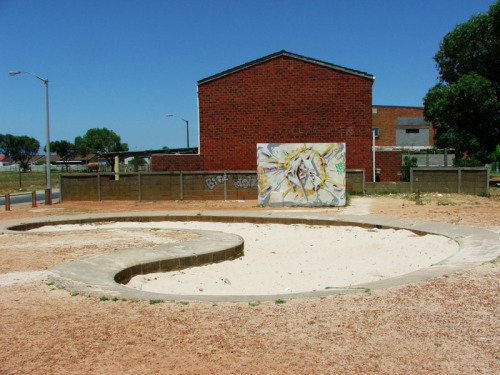
Westridge. Mitchells Plain
South African photographer Scott Williams is the second guest in our new weekly series. He has, he says, masqueraded as a freelance photographer during his lunchtimes and after-hours for some eight years. "I love to document the unseen, positive part of the Cape Town hip hop scene. The 'underground' (a dirty word), as it were. In the future, I'm planning to focus even more on Park Jams (free hip hop events held in communities) because I enjoy the thrill of a raw performance and the reaction of parents, friends, neighbours to their artists' hidden talents." More of Scott's work can be found at nar8iv.tumblr.com and on his flickr page. Along with his 5 favorite photographs, he sent us some words:
My first photo, above, was taken in Westridge, a suburb of the infamous Mitchells Plain in Cape Town. This particular location is a consistent favourite for DJ's, graffiti artists, breakdancers and MC's who are the organizers behind Park Jams. These sorts of events provide the opportunity for collaborations and interactions between people from areas separated by large distances. This image is also proof of the opportunity to examine some of the standard architecture templates used to execute the Group Areas Act's strategy.

Baby L. Hip Hop Connected
This photograph of Baby L was taken during the Hip Hop Connected show at the Artscape Theatre in 2005. This was the first hip hop show ever allowed on the Artscape stage since the inception of South Africa's "Democratic Era". Interestingly, the show played to a packed house on a fraction of the budget provided to the Theatre's Ballet productions.

Falko. Write for Gold
This particular piece of graffiti by Legendary artist Falko referenced a R50 note. To add a touch of whimsy to the shot I asked several people passing by whether they could hold up their currency. Eventually, I found a willing participant.
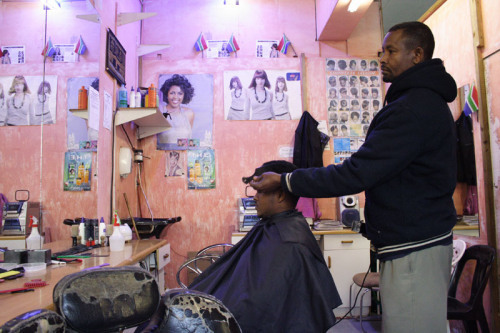
Little Mogadishu. Bellville
Bellville Middestad has been known as "Little Mogadishu" for a while because of the influx of Somali business people. Bellville is a junction of many intersecting transport routes in Cape Town and due to its concentration of travellers has logically become a profitable place to settle, especially for the Somali community whose businesses are often the target of xenophobic attacks. Ironically, these businesses often provide Capetonians with employment and promote regeneration of infrastructure. See how many South African flags you can find in this barbershop.
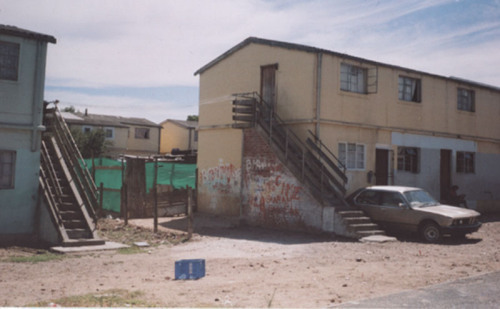
Klein Nederburg
This image was taken with an Olympus Trip35, a camera often referred to as "The Poor Man's Leica". I hardly ever switch to a film camera but my project with Paarl based MC Jaak required a different treatment. He had requested a nostalgic feel for some of the images, hence the deviation from the norm. The relationships formed with many hip hop artists have allowed me to visit communities — such as the one here in Klein Nederburg which I would never have visited on my own. The image taken is an example of how similar the architecture is to that of the Mitchells Plain area, despite the distance.


Sean Jacobs's Blog
- Sean Jacobs's profile
- 4 followers



